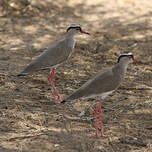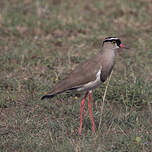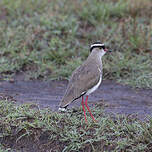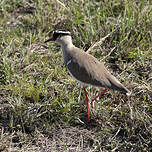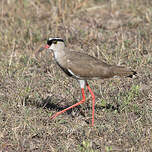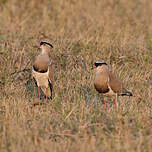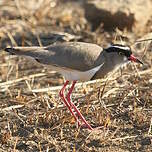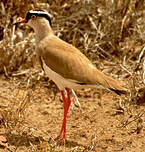Crowned Lapwing
Vanellus coronatus - Vanneau couronné
Identification
The Crowned Lapwing is a medium-sized lapwing (up to 32 cm long and a weight of 200g). The adult is immediately distinguished by its black head from the beak to the nape, up to the eyes wearing a white crown at the top and, therefore, cannot be confused with any other in its area. The eye has a yellow iris. The beak is two-coloured, reddish-crimson with a black tip. The sides of the head, the neck, the upper parts (mantle and back) and the chest are earth-coloured. From the beak to the bottom of the chest, the colour gradually goes from russet white to the throat to a strongly contrasting blackish-brown with a white belly. The legs are the same red as the base of the beak.
Seen in flight, the wings appear tricoloured on top (brown, white and black) and two-coloured underneath (white and black). The uppertail coverts and tail are white with a broad sub-terminal black band.
The juvenile resembles the adult less colourful. A white and black band runs from the forehead to the nape. Above, the brown crown is mottled with blackish. The upper tectrices are edged with fawn-coloured, giving a scaly appearance.
Subspecific information 2 subspecies
- Vanellus coronatus coronatus (Ethiopia and e Africa to Zambia and South Africa)
- Vanellus coronatus demissus (n Somalia)
Foreign names
- Vanneau couronné,
- Avefría coronada,
- abibe-coroado,
- Kronenkiebitz,
- koronás bíbic,
- Diadeemkievit,
- Pavoncella coronata,
- kronvipa,
- Kronvipe,
- cíbik korunkatý,
- čejka korunkatá,
- Kronvibe,
- kruunuhyyppä,
- Kroonkiewiet,
- fredeluga coronada,
- czajka koroniasta,
- Венценосный чибис,
- オウカンゲリ,
- 冕麦鸡,
- kronvipa,
- 冕麥雞,
Voice song and call
Like most lapwings, the Crowned Lapwing is an vocal bird, particularly during the breeding season. Its usual call, uttered to mark its territory, is a series of raucous kruis repeated at a frequency of about one per second. In cases of danger or taking off in flight, the notes become louder kris and the rhythm accelerates (5 to 6 per second).
Habitat
Behaviour character trait
Outside of the breeding season, the Crowned Lapwing lives in small groups, up to 20 individuals. During the breeding period, they live in pairs but are not territorial unlike most lapwings. It is mainly sedentary, especially in the driest areas. It can undertake some local movements during the rainy season to escape its effects, particularly to high grass. It is more active towards the end of the afternoon and the evening once the heat of the day has passed.
Dietfeeding habits
Reproduction nesting
The Crowned Lapwing is monogamous. It can reproduce all year round but the peak season is between July and November.
The nest, rudimentary, is a small depression in the ground, with some twigs, pebbles and animal dung, often in the shade of a bush or tree. Nests of different couples may not be very far apart. The female lays 2 or 3 eggs, rarely 4, whose color blends in with the ground. They are incubated by both parents for a period of 26 to 32 days. Adults attack predators or pretend to be injured to scare them away from the nest. Once the chicks are born, several families can join together to look after them. Despite this, many young are prey to snakes, birds of prey, mongooses or jackals before they can fly.Geographic range
Threats - protection
Sources of information
- IOC World Bird List (v15.1), Gill, F and D Donsker (Eds). 2025-12-07.
- Roberts Bird Guide, Hugh Chittenden
- Birds of Africa South of the Sahara, Ian Sinclair and Peter Ryan
- Handbook of the Birds of the World Vol 16, Josep del Hoyo, Andrew Elliott, David Christie
- Birds of the World, The Cornell Lab of Ornithology
Other sources of interest
 Specification sheet created on
30/07/2023 by Dietmar Petrausch
Specification sheet created on
30/07/2023 by Dietmar PetrauschTranslation by AI Oiseaux.net
© 1996-2025 Oiseaux.net
- Accipitriformes
- Aegotheliformes
- Anseriformes
- Apodiformes
- Apterygiformes
- Bucerotiformes
- Caprimulgiformes
- Cariamiformes
- Casuariiformes
- Charadriiformes
- Ciconiiformes
- Coliiformes
- Columbiformes
- Coraciiformes
- Cuculiformes
- Eurypygiformes
- Falconiformes
- Galliformes
- Gaviiformes
- Gruiformes
- Leptosomiformes
- Mesitornithiformes
- Musophagiformes
- Nyctibiiformes
- Opisthocomiformes
- Otidiformes
- Passeriformes
- Pelecaniformes
- Phaethontiformes
- Phoenicopteriformes
- Piciformes
- Podargiformes
- Podicipediformes
- Procellariiformes
- Psittaciformes
- Pterocliformes
- Rheiformes
- Sphenisciformes
- Steatornithiformes
- Strigiformes
- Struthioniformes
- Suliformes
- Tinamiformes
- Trogoniformes






















